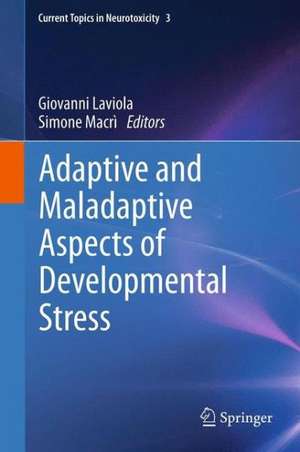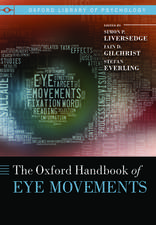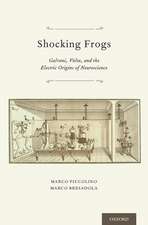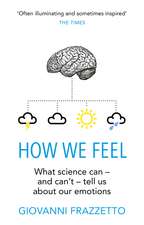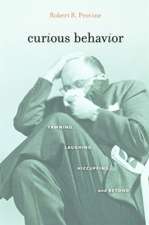Adaptive and Maladaptive Aspects of Developmental Stress: Current Topics in Neurotoxicity, cartea 3
Editat de Giovanni Laviola, Simone Macrìen Limba Engleză Hardback – 28 ian 2013
All those events that we call “stress” have the capability of perturbing a given state of psychological and physiological equilibrium and moving it to a different level. The transition from crawling to walking has to be considered a form of stress as much as losing a job.
It is through a continuous cross-talk between environmental stressors and individual adaptations that we build our personalities and our ways to cope with daily hassles. External challenges should not necessarily be regarded as “bad”, but instead seen as constructive forces forming our ability to navigate a changing world.
What is stress good for? What is stress bad for? When and why do we need to be “stressed”? Should we worry about stress? When does stress equate to “normality”? When does it turn into pathology? We hope with this book to provide some answers to these fundamental questions.
| Toate formatele și edițiile | Preț | Express |
|---|---|---|
| Paperback (1) | 696.82 lei 6-8 săpt. | |
| Springer – 28 iun 2015 | 696.82 lei 6-8 săpt. | |
| Hardback (1) | 948.92 lei 6-8 săpt. | |
| Springer – 28 ian 2013 | 948.92 lei 6-8 săpt. |
Preț: 948.92 lei
Preț vechi: 1157.22 lei
-18% Nou
Puncte Express: 1423
Preț estimativ în valută:
181.58€ • 190.06$ • 151.13£
181.58€ • 190.06$ • 151.13£
Carte tipărită la comandă
Livrare economică 31 martie-14 aprilie
Preluare comenzi: 021 569.72.76
Specificații
ISBN-13: 9781461456049
ISBN-10: 1461456045
Pagini: 296
Ilustrații: XII, 281 p.
Dimensiuni: 155 x 235 x 22 mm
Greutate: 0.54 kg
Ediția:2013
Editura: Springer
Colecția Springer
Seria Current Topics in Neurotoxicity
Locul publicării:New York, NY, United States
ISBN-10: 1461456045
Pagini: 296
Ilustrații: XII, 281 p.
Dimensiuni: 155 x 235 x 22 mm
Greutate: 0.54 kg
Ediția:2013
Editura: Springer
Colecția Springer
Seria Current Topics in Neurotoxicity
Locul publicării:New York, NY, United States
Public țintă
Professional/practitionerCuprins
Making Sense of Stress: An Evolutionary-Developmental Framework.- Prenatal and maternal psychosocial stress in primates: adaptive plasticity or vulnerability to pathology?.- The Everyday Stress Resilience Hypothesis: Unfolding resilience from a perspective of everyday stress and coping.- Ontogeny of stress reactivity in the human child: Phenotypic flexibility, trade-offs, and pathology.- Consequences of Developmental Stress in Humans: Prenatal Stress.- Consequences of Developmental Stress in Humans: Adversity experienced during Childhood and Adolescence.- Behavioural and neuroendocrine consequences of prenatal stress in rat.- Developmental consequences of prenatal administration of glucocorticoids in rodents and primates.- Early developmental trajectories of brain development: New directions in the search for early determinants of health and longevity.- Adaptive regulations in developing rodents following neonatal challenges.- Adaptive and maladaptive regulations in response to environmental stress in adolescent rodents.- Oxidative stress and hormetic responses in the early life of birds.
Recenzii
From the reviews:
“This book explores the positive and negative effects of stress, using a developmental perspective from prenatal experiences through adolescence. It also examines animal models to see how rodents, primates, and birds adapt to stress early in development. … Both clinicians and researchers would benefit from this book. … This book is well written by an international collection of experts in the field and is full of research findings. Readers with a solid background in physiological psychology and ethology will find this book very interesting.” (Gary B. Kaniuk, Doody’s Book Reviews, July, 2013)
“This book explores the positive and negative effects of stress, using a developmental perspective from prenatal experiences through adolescence. It also examines animal models to see how rodents, primates, and birds adapt to stress early in development. … Both clinicians and researchers would benefit from this book. … This book is well written by an international collection of experts in the field and is full of research findings. Readers with a solid background in physiological psychology and ethology will find this book very interesting.” (Gary B. Kaniuk, Doody’s Book Reviews, July, 2013)
Textul de pe ultima copertă
Since the very early stages of life, we all experience some form of stress. Stressors can be mild to severe and can range from unsuccessfully longing for maternal milk in infancy, to recklessly wiggling on a motorbike to be on time to watch the NBA finals on TV, to breaking up a relationship.
All those events that we call “stress” have the capability of perturbing a given state of psychological and physiological equilibrium and moving it to a different level. The transition from crawling to walking has to be considered a form of stress as much as losing a job.
It is through a continuous cross-talk between environmental stressors and individual adaptations that we build our personalities and our ways to cope with daily hassles. External challenges should not necessarily be regarded as “bad”, but instead seen as constructive forces forming our ability to navigate a changing world.
What is stress good for? What is stress bad for? When and why do we need to be “stressed”? Should we worry about stress? When does stress equate to “normality”? When does it turn into pathology? We hope with this book to provide some answers to these fundamental questions.
All those events that we call “stress” have the capability of perturbing a given state of psychological and physiological equilibrium and moving it to a different level. The transition from crawling to walking has to be considered a form of stress as much as losing a job.
It is through a continuous cross-talk between environmental stressors and individual adaptations that we build our personalities and our ways to cope with daily hassles. External challenges should not necessarily be regarded as “bad”, but instead seen as constructive forces forming our ability to navigate a changing world.
What is stress good for? What is stress bad for? When and why do we need to be “stressed”? Should we worry about stress? When does stress equate to “normality”? When does it turn into pathology? We hope with this book to provide some answers to these fundamental questions.
Caracteristici
Written by experts in the field Contains up-to-date information Features full-color images Includes supplementary material: sn.pub/extras
